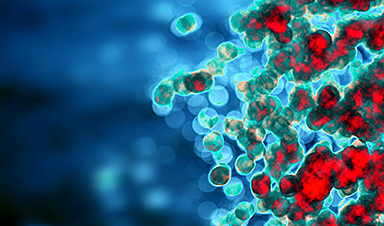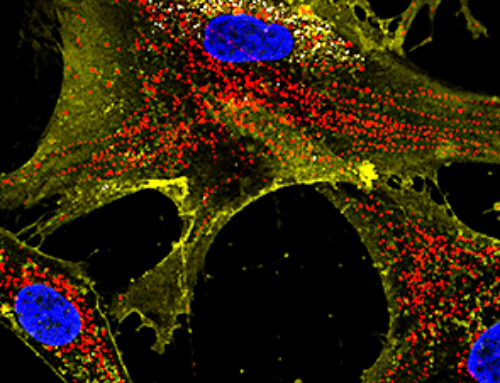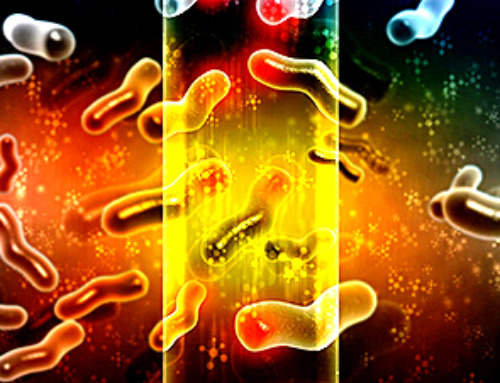Scientists at Scripps Research have reported success in initial tests of a new, nanotech-based strategy against autoimmune diseases.
The scientists, who reported their results in ACS Nano, engineered cell-like “nanoparticles” that target only the immune cells driving an autoimmune reaction, leaving the rest of the immune system intact and healthy. The nanoparticles greatly delayed, and in some animals even prevented, severe disease in a mouse model of arthritis.
“The potential advantage of this approach is that it would enable safe, long-term treatment for autoimmune diseases where the immune system attacks its own tissues or organs—using a method that won’t cause broad immune suppression, as current treatments do,” says study senior author James Paulson, Ph.D., Cecil H. and Ida M. Green Chair of Chemistry in the Department of Molecular Medicine at Scripps Research.
Autoimmune diseases such as rheumatoid arthritis are caused when the immune system mistakenly attacks a person’s own tissues or organs. These illnesses affect an estimated 10 million people in the U.S. alone. Treatments are available and can be effective for many patients, but they tend to suppress the immune system indiscriminately, creating an enhanced susceptibility to infections and cancers—among other side effects.
Paulson and his team have taken an approach that targets the immune system more narrowly. Many autoimmune diseases are triggered or driven by immune attacks on just one protein in the patient’s body, known as a “self-antigen.”
The idea underlying the nanoparticle strategy is to eliminate or deactivate only the immune cells that attack that self-antigen—an approach that could be at least as effective as broad immune suppression, without the side effects. Autoimmune diseases that are dominated by immune responses to a single self-antigen include some forms of arthritis, the skin blister disease known as pemphigus and the thyroid ailment Graves’ disease.
The researchers, including first author Katarzyna Brzezicka, Ph.D., a postdoctoral research associate in the Paulson lab, research assistant Britni Arlian, and other lab members, designed nanoparticles that could deactivate two types of immune cells: B cells and T cells.
On its surface, each nanoparticle bore copies of a target self-antigen, plus a sugar-related molecule that can bind to a special “off switch” receptor on B cells called CD22. B cells, which make antibodies and are specific to different antigens, will effectively shut themselves off if they encounter both the particular antigen they target and the binding partner of CD22 at the same time.
Each nanoparticle also was laced with a powerful compound called rapamycin to stimulate the production of immune cells called regulatory T cells. Treg cells, as they’re also known, are responsible for suppressing other T cells needed to generate an autoimmune attack. The overall aim of the study was to effectively knock out only the B and T cells that recognize the self-antigen, leaving the rest of the B- and T-cell populations intact.
The researchers first demonstrated that their nanoparticle-based strategy could tolerize the mouse immune system to a chicken protein, ovalbumin, that would otherwise trigger a strong response. Next, they tested the strategy in a widely used mouse model of arthritis, in which the mouse immune system is genetically predisposed to attack a self-antigen called GPI.
The scientists showed that treatment of the mice with GPI-tolerizing nanoparticles at the age of three weeks greatly delayed the development of arthritis signs that would normally appear a week or two later. In fact, about a third of the mice remained arthritis-free for the maximum follow-up period of 300 days. Tests confirmed that the treatment dramatically reduced the mice’s production of anti-GPI antibodies, and at the same time boosted their Treg populations.
Paulson says his team plans to follow up these highly promising results with further optimization of the nanoparticle strategy.
“We were able to ‘cure’ a third of these animals in this early demonstration, and I think there’s the potential to combine our nanoparticles with other immune modulator treatments to make it even more effective,” Paulson says. “So that will our next step—as well as demonstrating our technology against other autoimmune diseases caused by unwanted immune responses to a self-antigen.”
News
Novel mRNA therapy curbs antibiotic-resistant infections in preclinical lung models
Researchers at the Icahn School of Medicine at Mount Sinai and collaborators have reported early success with a novel mRNA-based therapy designed to combat antibiotic-resistant bacteria. The findings, published in Nature Biotechnology, show that in [...]
New skin-permeable polymer delivers insulin without needles
A breakthrough zwitterionic polymer slips through the skin’s toughest barriers, carrying insulin deep into tissue and normalizing blood sugar, offering patients a painless alternative to daily injections. A recent study published in the journal Nature examines [...]
Multifunctional Nanogels: A Breakthrough in Antibacterial Strategies
Antibiotic resistance is a growing concern - from human health to crop survival. A new study successfully uses nanogels to target and almost entirely inhibit the bacteria P. Aeruginosa. Recently published in Angewandte Chemie, the study [...]
Nanoflowers rejuvenate old and damaged human cells by replacing their mitochondria
Biomedical researchers at Texas A&M University may have discovered a way to stop or even reverse the decline of cellular energy production—a finding that could have revolutionary effects across medicine. Dr. Akhilesh K. Gaharwar [...]
The Stunning New Push to Protect the Invisible 99% of Life
Scientists worldwide have joined forces to build the first-ever roadmap for conserving Earth’s vast invisible majority—microbes. Their new IUCN Specialist Group reframes conservation by elevating microbial life to the same urgency as plants and [...]
Scientists Find a Way to Help the Brain Clear Alzheimer’s Plaques Naturally
Scientists have discovered that the brain may have a built-in way to fight Alzheimer’s. By activating a protein called Sox9, researchers were able to switch on star-shaped brain cells known as astrocytes and turn them into [...]
Vision can be rebooted in adults with amblyopia, study suggests
Temporarily anesthetizing the retina briefly reverts the activity of the visual system to that observed in early development and enables growth of responses to the amblyopic eye, new research shows. In the common vision [...]
Ultrasound-activated Nanoparticles Kill Liver Cancer and Activate Immune System
A new ultrasound-guided nanotherapy wipes out liver tumors while training the immune system to keep them from coming back. The study, published in Nano Today, introduces a biodegradable nanoparticle system that combines sonodynamic therapy and cell [...]
Magnetic nanoparticles that successfully navigate complex blood vessels may be ready for clinical trials
Every year, 12 million people worldwide suffer a stroke; many die or are permanently impaired. Currently, drugs are administered to dissolve the thrombus that blocks the blood vessel. These drugs spread throughout the entire [...]
Reviving Exhausted T Cells Sparks Powerful Cancer Tumor Elimination
Scientists have discovered how tumors secretly drain the energy from T cells—the immune system’s main cancer fighters—and how blocking that process can bring them back to life. The team found that cancer cells use [...]
Very low LDL-cholesterol correlates to fewer heart problems after stroke
Brigham and Women's Hospital's TIMI Study Group reports that in patients with prior ischemic stroke, very low achieved LDL-cholesterol correlated with fewer major adverse cardiovascular events and fewer recurrent strokes, without an apparent increase [...]
“Great Unified Microscope” Reveals Hidden Micro and Nano Worlds Inside Living Cells
University of Tokyo researchers have created a powerful new microscope that captures both forward- and back-scattered light at once, letting scientists see everything from large cell structures to tiny nanoscale particles in a single shot. Researchers [...]
Breakthrough Alzheimer’s Drug Has a Hidden Problem
Researchers in Japan found that although the Alzheimer’s drug lecanemab successfully removes amyloid plaques from the brain, it does not restore the brain’s waste-clearing system within the first few months of treatment. The study suggests that [...]
Concerning New Research Reveals Colon Cancer Is Skyrocketing in Adults Under 50
Colorectal cancer is striking younger adults at alarming rates, driven by lifestyle and genetic factors. Colorectal cancer (CRC) develops when abnormal cells grow uncontrollably in the colon or rectum, forming tumors that can eventually [...]
Scientists Discover a Natural, Non-Addictive Way To Block Pain That Could Replace Opioids
Scientists have discovered that the body can naturally dull pain through its own localized “benzodiazepine-like” peptides. A groundbreaking study led by a University of Leeds scientist has unveiled new insights into how the body manages pain, [...]
GLP-1 Drugs Like Ozempic Work, but New Research Reveals a Major Catch
Three new Cochrane reviews find evidence that GLP-1 drugs lead to clinically meaningful weight loss, though industry-funded studies raise concerns. Three new reviews from Cochrane have found that GLP-1 medications can lead to significant [...]





















